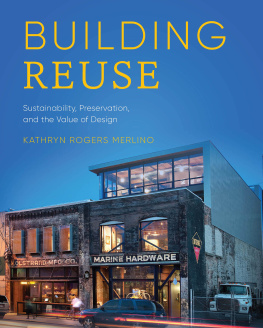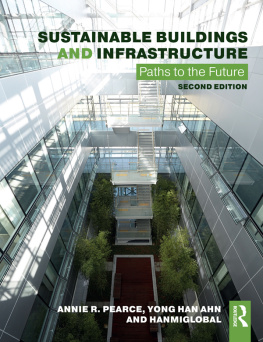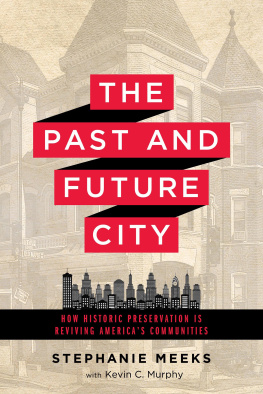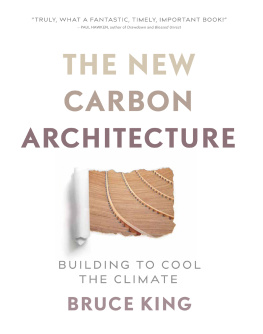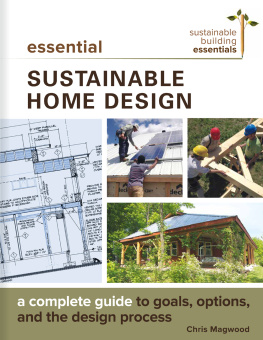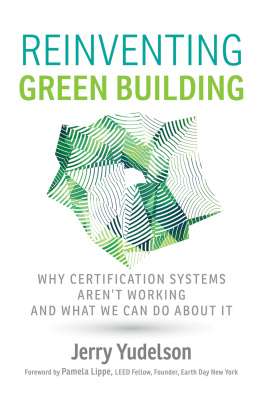
SUSTAINABLE DESIGN SOLUTIONS FROM THE PACIFIC NORTHWEST
DAVID E. MILLER, SERIES EDITOR
Architects of the Pacific Northwest have been celebrated for a long-standing respect for the environment and a holistic view of our place in it. This series spotlights innovative design achievements by contemporary Northwest architects, and supporting consultants, whose work reinforces core principles and ethics of sustainable design. Reflecting cross-disciplinary inspirations ranging from environmental sciences to sociology and systems biology, the pioneering buildings and technologies profiled in this series share common aesthetic and social goals. Promoting maximum energy efficiency through extensive use of recycled materials and minimal dependence on mechanical systems for heat, ventilation, and waste management, these works demonstrate a profound and enduring love of the natural world and its ecological systems.
Studio at Large: Architecture in Service of Global Communities
by Sergio Palleroni, with Christina Eichbaum Merkelbach
Toward a New Regionalism: Environmental Architecture in the Pacific Northwest
by David E. Miller
Daylighting Design in the Pacific Northwest
by Christopher M. Meek and Kevin G. Van Den Wymelenberg
Building Reuse: Sustainability, Preservation, and the Value of Design
by Kathryn Rogers Merlino
BUILDING REUSE
Sustainability, Preservation, and the Value of Design
KATHRYN ROGERS MERLINO

University of Washington Press SEATTLE
Building Reuse was supported by a grant from the University of Washington Press Endowment for Books on the Built Environment, established through the generosity of Betty Wagner and other donors.
Additional support was provided by the University of Washington Architecture Publications Fund.
Copyright 2018 by the University of Washington Press
Printed and bound in South Korea
Interior design by Stacy Wakefield
Composed in Cassia, typeface designed by Dieter Hofrichter
22 21 20 19 185 4 3 2 1
All rights reserved. No part of this publication may be reproduced or transmitted in any form or by any means, electronic or mechanical, including photocopy, recording, or any information storage or retrieval system, without permission in writing from the publisher.
University of Washington Press
www.washington.edu/uwpress
LIBRARY OF CONGRESS CATALOGING-IN-PUBLICATION DATA
Names: Merlino, Kathryn Rogers, author.
Title: Building reuse : sustainability, preservation, and the value of design / Kathryn Rogers Merlino.
Description: Seattle : University of Washington Press, 2018. | Series: Sustainable design solutions from the Pacific Northwest | Includes bibliographical references and index. |
Identifiers: LCCN 2017048939 (print) | LCCN 2017049814 (ebook) | ISBN 9780295742359 (ebook) | ISBN 9780295742342 (hardcover : alk. paper)
Subjects: LCSH: Sustainable architecture. | ArchitectureConservation and restoration. | BuildingsRemodeling for other use. | Architecture and society.
Classification: LCC NA2542.36 (ebook) | LCC NA2542.36 .M465 2018 (print) | DDC 720/.47dc23
LC record available at https://lccn.loc.gov/2017048939
COVER PHOTOGRAPH: The Kolstrand Building is located just outside the Ballard Avenue Historic District in Seattle. Challenged with an incredibly tight budget, the building celebrates the industrial vernacular of the neighborhood while adding additional office space, transparency at the street, and lively indoor/outdoor spaces. (Photo by author)
TO STEVE, MAIA, AND ROMAN

CONTENTS
PREFACE
THIS BOOK HAS changed dramatically since I began it several years ago, as has the city in which I wrote it. In the past few years alone, Seattle, my hometown, has been through an intense and dramatic transformation owing to a population surge in the region. Construction is everywhere. Neighborhoods have been lost in whole or in part and older buildings have been lost by the hundreds. This has made the subject of this book even more timely. While I love well-designed new buildings and realize change is inevitable and necessary, it is the intersection of old and new in cities that most intrigues me. I am confident we can find a way to let preservation, development, and sustainability drive the narrative in order to make and maintain beautiful, functional, equitable, and healthy cities. This is where I began with this manuscript, and where I continue to pursue my academic inquiries.
Trained as an architect and architectural historian, I have been drawn to older buildings since I can remember. This interest flourished during my participation in the Architecture in Rome Program at the University of Washington as an undergraduate architecture student under the tutelage of the late Professor Astra Zarina and Professor Emerita Trina Deines. I am eternally grateful to Astra for showing me how to see architectureparticularly, how to really observe and understand the constructed city as a layered palimpsest, read its past, and appreciate the possibilities it holds for the future. (It cannot be left unsaid that she also taught me the joy, appreciation, and absolute love of cooking.) This adoration of history grew deeper as I moved to Charlottesville, Virginia, and studied and lived among incredible artifacts of our own countrys history, which gave me a deep respect for the diverse people who produced this countrys rich built heritage.
This book has been, in part, the work of many talented students, assistants, and colleagues, who gathered research, took photos, and contributed their comments on content; I am especially grateful to Kelly Laleman and Kira Connery for their excellent assistance in initially researching the case studies for this book. I also thank Patrice Frey, Liz Dunn, Holly Taylor, Barbara Campagna, Jessica Miller, Amanda Reed, and all the students in my Building Reuse class who, over the years, contributed greatly to the conversation about sustainable building reuse, preservation, and design. And I thank Professor Dave Miller, who, as chair of the Department of Architecture, not only supported me in my role in administration as a young, untenured professor but also was incredibly patient during the production of this book. I extend my thanks, as well, to Professor Jeffrey Ochsner, a colleague whose dedication to preserving the historic fabric of our city remains forever inspirational, and whose insights, advice, and assistance have been valuable at every turn of my academic career. Great thanks go to my editors at the University of Washington Press, who made this book possible through very hard work, and to the extraordinary editors and designers who made such a beautiful product to hold in ones hands.
This book is dedicated to the memory of my father, Jim Rogers, who passed while I was working on the manuscript. As a talented craftsman, he fostered my love for architecture and building by letting me hammer, nail, and saw in his workshop and fix flashing on the roof of our midcentury home, and by showing me that I could fix nearly anything myself. The book is also dedicated to my generous mother, whose abundant support and love have always been steadfast and limitless. And I could not ever leave out the best in-laws, Jane and Ed Merlino, who, as educators themselves, are always interested in and supportive of everything I do. The biggest thanks go to my brilliant, patient, loving husband, Steve (the real writer in the familyfor I would rather draw), for, well, everything. And to the other two loves of my life, Maia and Roman, for being the most intelligent, compassionate, extraordinary children a parent could ask for.
Next page
